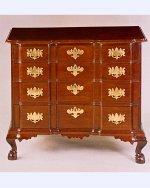I am currently drawing plans for the John Chipman blockfront chest of drawers on display in the Diplomatic Reception Rooms of the U.S. Department of State. When finished they will be free to SAPFM members. I will have Mark post them on the member’s only forum.
John McAlister graciously loaned me his set of plans to reference. With John’s permission I have altered the construction to be more in line with the original. I need some information on a few details if any member has that or has an opinion. The overhang on the top in relationship to the sides and front, is it equal or is the front overhang smaller. What is the usual drawer front thickness? I have seen from 13/16” to 1 1/2:”
Cock beading: is it 1/8” wide and 1/16” in depth or is the depth more than 1/16”.
I tried calling the curators in charge of the Diplomatic Reception Rooms but they refused any help.
This does not have to be exact just some general guidelines.
Ed Stuckey
John McAlister graciously loaned me his set of plans to reference. With John’s permission I have altered the construction to be more in line with the original. I need some information on a few details if any member has that or has an opinion. The overhang on the top in relationship to the sides and front, is it equal or is the front overhang smaller. What is the usual drawer front thickness? I have seen from 13/16” to 1 1/2:”
Cock beading: is it 1/8” wide and 1/16” in depth or is the depth more than 1/16”.
I tried calling the curators in charge of the Diplomatic Reception Rooms but they refused any help.
This does not have to be exact just some general guidelines.
Ed Stuckey

